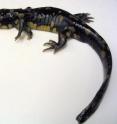Study rules out inbreeding as cause of amphibian deformities
Although research has linked inbreeding with elevated rates of deformity in a wide variety of animals, a new study finds it plays no part in the high incidence of malformation among salamanders. Purdue University researchers recently examined 2,000 adult and juvenile salamanders and found that 8 percent had visible deformities, mainly consisting of missing, extra or dwarfed digits (equivalent to fingers and toes). That is double the rate of malformation found in newts, a related amphibian, but on par and with frequencies seen in many frog species, said assistant professor of forestry and natural resources Rod Williams.
"This is really the first study to test - and disprove - the hypothesis that inbreeding is responsible for malformations in salamanders," said Williams, corresponding author of the study published recently in the journal Biology Letters.
Like many types of amphibians, tiger salamanders return to the same pond throughout their lives to mate. Williams and his former doctoral adviser, lead author Andrew DeWoody, hypothesized that habitat fragmentation or other factors might increase the probability that related salamanders could return to the same spot and mate.
But their study found animals' genetic backgrounds to be unrelated to deformation rates; deformed salamanders were no more inbred than normal individuals. The population proved to be quite diverse, in fact, with roughly twice as much genetic variation as most land animals, DeWoody said.
They calculated relatedness by measuring frequencies of alleles, which are copies or pairs of genes whose ratios are abnormally skewed in inbred individuals.
High rates of amphibian malformation concern scientists not only because they threaten the survival of certain important species, but also because of what they signify about the health of the environment, said DeWoody, an associate professor.
"Amphibians are a good bio-indicator species - real canaries in the coal mine," Williams said.
Amphibians are more heavily impacted by water pollutants because of their semipermeable skin. Many species also begin life in water, where they risk contaminant exposure during their most vulnerable years, Williams said.
The reason for high rates of deformation in salamanders, frogs and other amphibians remains a mystery, DeWoody said. With inbreeding ruled out, however, environmental factors like parasites, ultraviolet radiation and water pollution remain prime suspects, he said.
Williams and DeWoody are actively looking for a cause or causes that may shed light upon high levels of malformation in frogs and other amphibians.
"We've crossed out inbreeding as a possibility, an important step forward," DeWoody said. "But there's a lot of work yet to do."
Source: Purdue University
Other sources
- Mystery of the five-legged freaksfrom MSNBC: ScienceWed, 29 Oct 2008, 20:56:22 UTC
- Mystery of the 5-Legged Freaksfrom Live ScienceWed, 29 Oct 2008, 14:10:26 UTC
- Study rules out inbreeding as cause of amphibian deformitiesfrom PhysorgTue, 28 Oct 2008, 19:14:27 UTC
- Salamander inbreeding: No deformity linkfrom UPITue, 28 Oct 2008, 17:21:11 UTC
